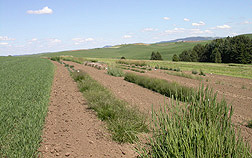Managing Grass Germplasm and Its Microbial Tenants
|
|
The Western Regional Plant Introduction Station (WRPIS) in Pullman, Washington—one of four plant introduction stations in ARS’s National Plant Germplasm System—boasts one of the world’s largest collections of cool-season forage and turfgrasses, totaling nearly 21,000 accessions.
It’s also a treasure trove of microbial germplasm in the form of endophytes, a specialized group of Neotyphodium fungi that live symbiotically within certain grasses.
The endophtyes’ presence in grasses can be a mixed blessing, however. On one hand, they produce metabolites that naturally repel and reduce survival of important insect pests while also bolstering the grasses’ stress tolerance, especially to drought. On the other hand, some of the metabolites, notably ergot alkaloids, produced by the endophyte in grasses like tall fescue are the primary cause of fescue toxicosis in grazing livestock.
Fortunately, intensive research over the past several years has identified new endophyte strains that don’t cause fescue toxicosis but still confer desirable benefits. A notable example is the discovery by New Zealand scientists of a non-ergot-producing endophyte strain during their examination of a fescue accession from WRPIS that originated in Morocco. These scientists inserted this nontoxic strain into tall fescue varieties, now marketed under the brand name MaxQ. Some consider MaxQ fescues to be promising replacements for the widely used Kentucky-31 tall fescue variety in the United States, which contains a toxic endophyte.
According to ARS entomologist Steve Clement, public and private research organizations in the United States and abroad are increasingly mining the WRPIS grass collection to identify more nontoxic strains. Such interest underscores the importance of considering grass endophytes as important components of biodiversity that, like grass accessions, must be conserved for research and development. In this regard, research by Clement and collaborating scientists at ARS’s Forage Seed and Cereal Research Unit in Corvallis, Oregon, showed that current seed-regeneration practices at WRPIS are suitable for maintaining viable grass endophytes for storage in the genebank.
Clement is also conducting studies to better characterize the diverse grass-endophyte associations that exist in the collection and the anti-insect properties of these associations. That information, in turn, should help scientists better understand the potential for using endophytes to endow cereal crops like wheat and barley with resistance to insects and abiotic stresses.
Of particular interest are the protective effects of grass endophytes and their specific metabolites against globally important insect pests of forage and cereal grasses. In recent research, Clement observed a decline in the survival of cereal leaf beetles—new invasive pests of Pacific Northwest seed nurseries—that fed on endophyte-infected grasses. Very few cereal leaf beetles survived after eating leaves from endophyte-infected wild tall fescue (Lolium arundinaceum) accessions originating from North Africa and stored at WRPIS.
“As the science of endophyte discovery and conservation develops, we’ll see expanded opportunities for using these unique fungi in agriculture,” says Clement.—By Jan Suszkiw, Agricultural Research Service Information Staff.
This research supports the USDA priority of promoting international food security and is part of Plant Genetic Resources, Genomics, and Genetic Improvement, an ARS national program (#301) described at www.nps.ars.usda.gov.
Stephen Clement is in the USDA-ARS Plant Germplasm Introduction and Testing Research Unit, Western Regional Plant Introduction Station, 59 Johnson Hall, Pullman, WA 99164; (509) 335-3572.
"Managing Grass Germplasm and Its Microbial Tenants" was published in the January 2011 issue of Agricultural Research magazine.







